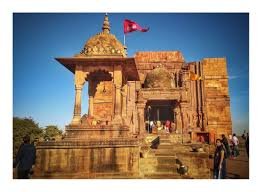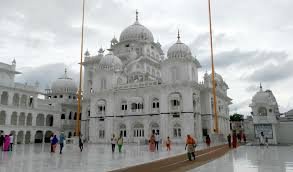Nestled in the serene village of Bhojpur in Madhya Pradesh, Bhojeshwar Temple stands as a magnificent testament to India’s rich architectural and spiritual heritage. Dedicated to Lord Shiva, this grand yet incomplete temple is often referred to as the “Somnath of the East” due to its colossal Shiva Lingam. One of the largest in India. Built by Raja Bhoj, a visionary ruler of the Paramara dynasty. The temple is an architectural wonder that continues to fascinate historians, devotees, and travelers alike.
From its intricate stone carvings to its massive monolithic lingam, the Bhojeshwar Temple is not just a place of worship but also a masterpiece of medieval engineering. Despite remaining unfinished, its aura of divinity and artistic brilliance makes it one of Madhya Pradesh’s most significant spiritual and historical landmarks.
Historical Background
The history of Bhojeshwar Temple dates back to the 11th century, during the reign of Raja Bhoj (1010–1055 AD), one of India’s greatest scholar-kings. Known for his immense contributions to literature, art, and architecture, Raja Bhoj envisioned this temple as an architectural marvel dedicated to Lord Shiva.
However, for reasons still debated by historians—possibly war, lack of resources, or unforeseen calamities—the temple was never completed. Despite its unfinished state, the existing structure showcases the grandeur and vision of ancient Indian temple architecture.
Interestingly, ancient manuscripts suggest that Raja Bhoj himself played a significant role in designing the temple. And making it a unique representation of royal devotion and artistic ambition.
Architectural Grandeur
One of the most striking features of Bhojeshwar Temple is its sheer scale and simplicity, which contrasts with the highly ornate temples found in Khajuraho and other regions of Madhya Pradesh.
The Grand Shiva Lingam
The temple houses a massive Shiva Lingam, measuring about 7.5 feet (2.3 meters) in height and 17.8 feet (5.4 meters) in circumference. Carved out of a single rock, this monolithic lingam rests on an equally impressive three-tiered platform, symbolizing Lord Shiva’s supreme power.
Towering Entrance and Walls
Although incomplete, the temple’s architectural layout suggests that it was designed to have a towering shikhara (spire), similar to other grand Shiva temples. The existing structure consists of a massive stone sanctum with thick walls and intricately carved doorways.
Absence of a Mandapa (Prayer Hall)
Unlike most Hindu temples, Bhojeshwar Temple does not have a mandapa (prayer hall). Despite this, the open sanctum allows natural light to illuminate the sacred space, adding to its mystical charm.
Massive Stone Blocks and Carvings
The temple’s stone blocks, some weighing several tons, were meticulously placed to create a structure that could withstand the test of time. Intricate carvings of deities, floral patterns, and geometric designs adorn the remaining portions of the temple, reflecting the artistic excellence of the Paramara period.
Spiritual Significance
Despite being incomplete, Bhojeshwar Temple remains an important pilgrimage site for Shiva devotees. Many believe that worshiping here brings divine blessings, inner peace, and spiritual fulfillment.
The temple attracts thousands of devotees, particularly during Mahashivaratri, when a grand celebration takes place. On this auspicious day, pilgrims from across the country gather to offer prayers, chant mantras, and seek Lord Shiva’s divine blessings.
Legends and Myths
The Curse of Incompletion
One of the most fascinating legends about Bhojeshwar Temple is that it was never completed due to a divine curse. According to folklore, a celestial voice warned Raja Bhoj that if he continued constructing the temple. Then his kingdom would face destruction. Fearing the prophecy, the construction was halted, leaving the temple in its present state.
The Link to River Saraswati
Another legend suggests that Raja Bhoj built the temple in an attempt to restore the lost Saraswati River, which was believed to have once flowed through this region.
Why Visit Bhojeshwar Temple?
Visiting Bhojeshwar Temple is not just about exploring an ancient structure—it’s about experiencing a place where history, spirituality, and architectural brilliance converge. Here’s why you should add it to your travel list:
- A Glimpse into Ancient Engineering: The temple’s massive stone blocks and unfinished carvings reveal the advanced architectural techniques of the 11th century.
- Divine and Serene Atmosphere: The tranquil surroundings and spiritual energy make it an ideal place for meditation and reflection.
- A Photographer’s Paradise: The majestic Shiva Lingam, ancient stone structures, and picturesque setting offer stunning photo opportunities.
- Connection with History: Walking through this temple allows visitors to connect with the legacy of Raja Bhoj. One of India’s most legendary rulers.
Best Time to Visit
The best time to visit Bhojeshwar Temple is during winter (October to March) when the weather is pleasant. If you wish to witness the temple in its most vibrant spiritual form, visiting during Mahashivaratri is highly recommended.
Timings: 6:00 AM – 7:00 PM (Open all days)
Entry Fee: Free
How to Reach Bhojeshwar Temple
Bhojeshwar Temple is located in Bhojpur, Madhya Pradesh, about 28 km from Bhopal, the state capital.
- By Road: Regular buses, taxis, and private vehicles connect Bhopal to Bhojpur. The drive takes around 45 minutes.
- By Train: The nearest railway station is Bhopal Junction. Which is well connected to major cities like Delhi, Mumbai, and Chennai.
- By Air: The nearest airport is Raja Bhoj Airport, Bhopal, located about 40 km away.
Conclusion
The Bhojeshwar Temple may be an unfinished masterpiece, but its grandeur, history, and spiritual significance make it one of India’s most fascinating Shiva temples. From its colossal Shiva Lingam to its mystical legends. This temple continues to captivate visitors, drawing them into its world of ancient wisdom and devotion.
Whether you are a devotee, history enthusiast, or architecture lover. A visit to Bhojeshwar Temple promises an unforgettable journey into the past. Experience the timeless charm of this sacred temple and witness the legacy of Raja Bhoj. That still echoes through its stone walls.





